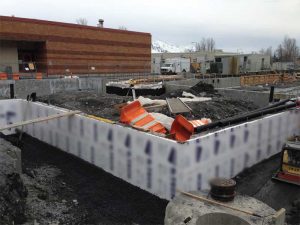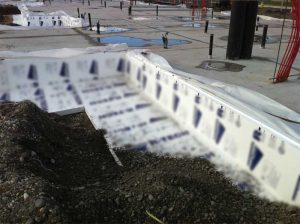
by Kevin Keith
The distant sound of hammers pounding and the low murmur of a crew’s radio announce a day of hectic construction. When the temperature warms up, excavators can easily turn up the soil and crews can pour concrete without risk of frost. Teams can also accomplish more work below-grade with extended hours of daylight.
During peak construction seasons, there is a renewed focus on materials that can ensure efficient, cost-effective structures starting at the foundation. Expanded polystyrene (EPS) rigid foam is among these solutions, and the customizable insulation material is a suitable choice for an array of residential and commercial applications.
Given EPS’ ability to repel water, withstand loads, and to maintain R-values throughout its time in service, the insulation lends itself well to today’s construction industry—one hungry for energy-efficient, cost-effective materials suitable for below-grade building endeavors.
The importance of below-grade insulation
Before pouring a foundation, energy-prudent builders need to consider adding insulation below-grade and under slab. If constructed without adequate insulation, bare slab concrete operates as a thermal bridge between a building’s heated interior and the cooler earth soil, a costly misstep for residential and commercial projects alike. For example, according to the EPS Industry Alliance (EPS-IA), lack of insulation on foundations, crawl spaces, and under slabs can account for up to 25 percent of a structure’s total energy loss. This unnecessary loss of energy can be damaging to an owner’s utility bill.

Fortunately, there are many below-grade insulation solutions on the market to aid in the energy efficiency of a structure, such as EPS. As one field study conducted by the Institute of Research in Construction (IRC) found, EPS is a durable basement insulation. After withstanding freeze-thaw cycles, the insulation showed no degradation of its physical and thermal properties, even when surrounded by moisture-laden heavy clay. The material was not only able to resist the presence of water, but also can effectively help conserve energy with its consistent R-values.
EPS’ physical properties
As noted in the above IRC study, EPS’ long-term, moisture-resistant physical properties can combat common below-grade challenges and are worth exploring in greater detail.
Moisture mitigation
For below-grade foundations, moisture management is critical. In these applications, insulation is frequently exposed to moist soil and runs the risk of becoming wet itself. Since moisture can negatively impact R-values and render the material ineffective, insulation used below-grade must demonstrate minimal retention of moisture in the long-term.
Real-world studies have proven EPS offers moisture-resistance below-grade (read “Technical Bulletin: 15-Year In-Situ Research Shows EPS Outperforms XPS in R-Value Retention”). Further, EPS exhibits drying potential when put under strenuous freeze-thaw cycles, which is very critical to maintaining consistent, long-term R-values. In climates where higher moisture shielding is vital for foundations and concrete slabs, EPS is available with water-impervious facers and pre-cut drainage channels.
Mold resistance
The presence of seeping moisture can also be detrimental to foundation walls and below-grade projects on the inside, serving as a breeding ground for interior mold and mildew. Since EPS ‘breathes,’ and, consequently, does not require expensive venting to mitigate moisture, moisture is less likely to be trapped in below-grade areas incorporating this material. By insulating with EPS, builders can reduce interior condensation and lower the risk of fungi impacting human health and potentially damaging foundational integrity.




